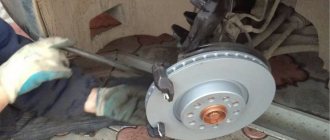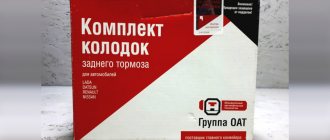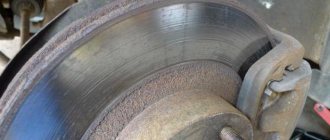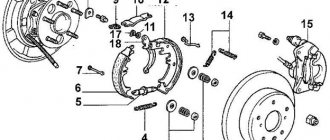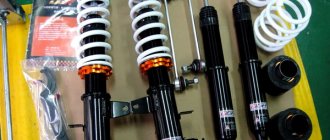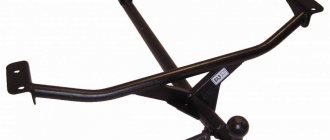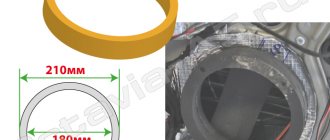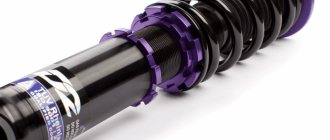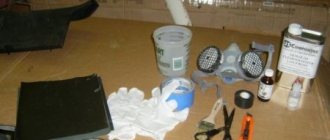When the driver realizes that a squeak appears when braking, the first thing that comes to his mind is to purchase anti-squeak brake pads. However, few people know what they are and what they are needed for. Beginners do not go into details when buying a car, but when characteristic sounds appear, they begin to look for a solution to the problem. Over time, squeaking begins to get on your nerves, so car owners either buy anti-squeak plates or make them themselves. Let's consider the main purpose of these elements, what materials they are made from and why the car starts to creak in the first place.
Brake pad design
Replacing brake pads is one of the cheapest car repairs. However, it is very important to comply with the planned deadlines, as well as monitor the level of wear and tear. The problem with pads is that it is very difficult to tell when they will reach the end of their life. They are hidden in clips behind the rims and are not easily accessible without removing the wheel. But every driver removes the wheels twice a year when periodically replacing tires, cars also undergo periodic technical inspections and registration checks. Although the condition of the brakes will be checked during the final procedures, do not forget to ask a tire mechanic to check the wear of the pads and brake rotors. You can also do it yourself - you don’t need to be a highly qualified specialist to see the need to replace the pads. This can also be done using a very simple but fairly accurate tool - a caliper.
The brake pads may look inconspicuous, but they are technically advanced. They consist of several layers:
1. Metal plate. It must be done very precisely so that the block fits perfectly after it is inserted and fixed in the clamp. There cannot be any play in it. The plate is covered with a special shockproof coating.
2. On the other side, the layer is attached to the plate with special glue, and friction material is attached to it.
3. The intermediate layer is about 2mm. Its task is to dampen vibrations and shocks, as well as thermally isolate the friction material from the plate. The point is that the brakes should not heat up or vibrate.
The biggest secret of each manufacturer is the composition of the mixture from which the friction material is made. It is known that there are mixtures of various metals, fiberglass, steel wool and special resins that bind everything together. The mixture also contains an admixture of ceramic materials.
There are also so-called ceramic brake pads. They contain relatively small amounts of graphite, which has been replaced by ceramic materials. The graphite in the brake pad acts as a dry lubricant, which is also why the brake does not immediately seize, and the pads gradually grind down on the disc, taking away its energy. Ceramic pads aren't much more expensive than regular pads, they generally brake a little better, are a little more durable, and above all, they don't stain your rims or cause dust. It is better to install ceramic blocks on new rather than used discs.
It is interesting that for the same car you can buy both “original” pads, that is, those with which the car left the factory, and many analogues with very different characteristics. Factory brake pads are a compromise between stopping power and durability. In particular, the friction coefficient is responsible for braking force. The higher it is, the more effective the brakes are, but sometimes they are less durable.
About resonance and lubrication
I know that now many people will start writing - I would like to hear more about the resonance of the disk and the friction lining itself. Actually, it’s no secret to anyone that when braking, the friction layer does not adhere evenly to the surface of the disc (this happens especially often when the surface is already fairly worn out). More precisely, it can vibrate and produce high-frequency sounds, which our ear picks up in the form of a creaking sound.
To get rid of it, we need to change the frequency of these sounds, that is, either change something specifically with the friction (soft) layer - sometimes it is sawed through in the middle or ground off along the edges.
BUT EXACTLY FOR COMBATING RESONANCE - anti-squeak elements are very effective, especially if you apply lubricant to the outer surface of the pad and press it with a plate. It turns out to be an improvised pie
A few words about lubricants, they use special, refractory, hardening ones (I won’t advertise the company, that’s not the point). They form a kind of rubberized layer on the outside that dampens all vibrations, including sound ones.
If you exaggerate it too much, try throwing a stone into a metal bathtub, you will have a bell effect. Now line the bottom with rubber mats and throw it again - there will be no such noise anymore. Anti-squeak plates also work.
How long will the pads last?
It is impossible to determine this unambiguously, because the durability of the pads depends on many factors. This mainly concerns driving style and conditions, as well as the car model. A heavy foot and sporty driving will cause the pads to wear out at 20 thousand km for one driver, and after 60 thousand km for another.
To simplify, we can say that the higher the coefficient of friction, the less durable the brakes. However, this primarily applies to typical sports pads, in which efficiency is most important, and durability takes a back seat. Interestingly, pads with more sporty characteristics are close in price to civilian ones. The most popular replacement options, such as Ferodo or Brembo, often brake much better than factory pads while still being just as durable. They don't (and shouldn't) fit on regular cars. Yes, they brake sensationally, but only at the right temperature - they require a solid warm-up, which is difficult to find in everyday driving.
Each car manufacturer specifies the maximum possible pad wear. New friction linings (usually) are several millimeters thick. Worn should not be less than 1.5 mm. This information can be found in your vehicle's owner's manual or from information available online on car company websites. Many models also have a mark on the edge that you should not go below. If the pad has the minimum permissible thickness, for example, 3 mm, and there is 6 mm left, then you need to think about replacing it. However, it is worth considering the amendment according to which, depending on driving style, the remaining 3 mm will be worn off after traveling 2-3 thousand km. So there's no need to rush.
Some pad models also have special inserts built into them that alert you when they need to be replaced. These are small elements made of different materials from the rest of the block that make noise when braking. A very simple and effective solution.
Boat trailer: buy or make it yourself
- Mitsubishi Lancer 9;
- VAZ 2110;
- Toyota Rav 4;
- Mazda 6;
- Toyota Corolla;
- Nissan Qashqai;
- Outlander XL;
- Mazda 3;
- Hyundai Solaris;
- Honda Accord;
- Audi A5, etc.
It is fair to mention that some motorists claim that anti-squeaks are ineffective.
This is indeed a fair statement. But not in all cases. Yes, there may be no effectiveness at all, or it may be invisible. This is mainly due to incorrect installation, the use of inappropriate components, or the use of plates made of poor quality material.
Experts also recommend combining the use of metal sheets with a special lubricant. Then you will be able to get the maximum benefit from such a modification. Plus, do not forget to check for possible wear of the brake discs and make sure that the cause of the squeaking is not at all due to serious malfunctions.
Determining the wear of the pads
If you hear a squealing sound when braking, something in the brakes probably needs replacing, usually the pads. Discs are expected to wear at half the rate of pads, so discs usually need to be replaced every other time the pads are replaced. A caliper is the best solution for measuring wear on both components. After removing the wheel, you can check how many pads and discs can still be worn.
Another alarming symptom is vibration when braking. Here, however, you need to make allowances for the fact that the suspension geometry could also be “worn out” - but it’s worth checking the brakes first, because their condition can be assessed faster, easier and at no additional cost.
After installing new pads, it is important to handle them very carefully for the first 100-200 km to allow them to adapt to the discs. Immediately pinching them under heavy braking can cause warping, cracking, caking and destruction of the discs. In theory, the pads and discs fit together perfectly. In practice, discs have microscopic curves and irregularities, just like pads. This cannot be seen with the naked eye and cannot be measured without the use of specialized, very precise instruments.
Dirt on the rims is a visible phenomenon indicating excessive pad wear. When driving, dust from the lugs accumulates on the wheel rims - this is normal. But when there is too much of it, a problem arises. Either the pads are too worn and wear out quickly, or their quality is poor, or the driver drives too roughly. In any case, their condition is worth checking.
The pads can be broken. This is rare, but possible. If a person presses the brake pedal all the way down while driving very fast, or keeps their foot on the brake pedal the whole time when going down a hill, they can damage the pads. If the friction is very strong and the temperature exceeds the limit value, the surface of the pads may be baked. A special glass-like layer is then created to prevent braking as it slides over the disc. Then both the pads and discs are usually replaced.
Why does the creak appear?
Unfortunately, the elements of the brake system wear out, but they do so unevenly. For example, the same pads wear out more on one edge than on the other. The discs, in turn, are subject to fragmented wear. Over time, a so-called gap appears between the pad and the disc. Adding to this problem is a wheel that deviates from the axle. Deviation occurs periodically when the pads do not fit tightly to the disc. This provokes the appearance of a squeak. To get rid of the squeak, you need to eliminate the problem.
Functions of anti-squeak plates
Many drivers are unclear about why they need to use anti-squeak plates. In order to understand the situation, it is necessary to give an example: the car had discs or drums resurfaced, while the car itself is new, purchased straight from the showroom.
As soon as the driver notices that a strange sound occurs when pressing the pedal, he begins to look for the source of this sound. Usually at this moment it becomes clear that there are no complaints about the quality of braking, but the sound still does not disappear. This situation can be solved simply by using anti-creaking plates. They help eliminate sounds when the car stops. All this happens due to the absorption of vibrations.
The plates are attached to the blocks, preventing distortions from occurring, but, on the contrary, transmitting force smoothly. The car brakes quickly and confidently, no sounds appear at the moment of stopping. As for misalignment, this is a normal phenomenon that occurs due to dirt or sand getting into the caliper. It is the misalignment that provokes the creaking. And to combat it, plates are required.
What other additional effects do these details have? With their help, you can deal with the problem of pad and disc resonance that occurs during braking. When operating a car with high mileage, the following happens: during braking, the disc touches the friction surface, and completely unevenly. Improper contact creates vibration. It is she who represents the unpleasant creak. In this situation, it is necessary to make changes to the friction layer, which can be done either with plates or with lubricant.
Purchase
Now you can find ready-made versions of such plates on sale, and the manufacturers of this part may be different. For example, Honda offers both universal plates that are suitable for any model, and original ones that are suitable for a specific modification. Some other brands have repairs. sets of records that are designed for several models that are created on the same base.
If you find plates in a store, be sure to check what cars they are intended for. It is better to buy cars created for your model, but you can also purchase universal options. Always use these parts on all wheels at once.
Pay attention to the material from which this part is made; it is best to buy stainless steel plates, they will last much longer. You should not buy Chinese parts; these spare parts are often of very low quality, which will lead to the need to quickly replace them. As a rule, you won’t find such components in regular stores, so the best way is to order anti-squeak plates online.
Manufacturing materials
Anti-squeak plates are made from different materials. They are usually made from pieces of metal that are cut to resemble the last. They are placed not on the friction side, but on the outside so that they rest against the piston. Some manufacturers do not install them, while others, on the contrary, replenish the kit with a couple of pieces along with lubricant.
The shape of the plates is also different. Sometimes they are smooth or with slots. The first type is installed so that it is adjacent to the piston. And the second type is used on the reverse side. The kit includes two types at once.
Description and purpose
Anti-creaking plates are also called balancing plates. Their main role is to redistribute the force from the brake piston over the entire surface of the pad. If dust or dirt gets in and there are no such plates, a slight misalignment of the pad may occur. This almost always causes an unpleasant sound from the brakes. That is why the plates are called anti-squeak plates.
Externally, they consist of two parts and are made of thin metal (tin). The plates follow the contours of the brake pad, and they are located on its non-working side, closer to the piston. The part that comes into direct contact with the brake piston looks like a solid plate. The other one, which is adjacent to the block, is corrugated. This is just necessary to be able to evenly distribute the force in the presence of contamination.
Should I use plates?
On the one hand, even without pads, sometimes the driver does not hear any sounds, and this does not bother him. The material of the parts is soft and proven. But on the other hand, it is impossible to protect the pads from distortion and contamination. That is why many car owners use plates that can combat the listed problems.
Anti-squeak pads help many people, but not always. Unfortunately, when buying cheap options, you can’t expect a miracle. For the pads to really work, you need to purchase more expensive models. Also, the products will not help if the driver’s piston is “covered” or the caliper is stuck. Here the problem is completely different; repair is required, not installation of overlays.
What are they made of?
Let's see what anti-squeak plates are made of. When choosing a material, you look at several things. First of all, they must be durable, because the pressure from the caliper is quite high. Also, these elements should not have any problems with corrosion, because water and reagents constantly get on the wheels, so the risk of rust is quite high. As a result, not all materials are suitable for this purpose.
The best options for creating these plates are stainless steel and galvanized steel. But the last option is much worse. Galvanized steel is just not that strong. She also has a problem with peeling off the protective layer. Therefore, stainless steel is the best option. In some cases, non-ferrous metals, such as bronze, are used. But, it has a number of disadvantages. In particular, it is less dense, which negatively affects the efficiency of the part. In addition, bronze is a fairly expensive material, and it is not always rational to use it for consumable components.
Is it worth installing anti-squeak plates?
There is a sharp sound when braking in any case, but it should be natural. If the sound is too harsh, then this indicates the poor condition of the brake pads and discs, and if even normal sound interferes, then it is necessary to install anti-squeak plates. These are special elements that are installed both on plates and on pads. They help eliminate unpleasant sound. The bottom line is that the installed plates absorb all vibrations, which is why sound simply does not occur. At the same time, with their help it is possible to get rid of the existing misalignment and improve the braking force. Sometimes they help reduce wear on the pads themselves, but you cannot rely on the plates and not change them when they wear out. In addition, thanks to the plates, there is no resonance between the pads and discs during braking.
It is worth noting that in addition to the plates themselves, a lubricant is also used; it must be heat-resistant, since during braking the elements heat up to extremely high temperatures, and if the lubricant is not suitable, it will not withstand the temperature regime.
Considering the load they will be subjected to, the material they are made of must be of high quality. It is curious that the plates are made of metal, or rather tin or stainless steel. As for the shape, it is specially cut according to the parameters of the brake pad so that the owner does not have problems with their installation. Installation takes place on the reverse side of the pad so that they can rest against the piston or the reverse part. In this case, you can buy the pads themselves, on which such plates will already be installed, but this is not a very common practice. They can be solid or have special slots.
Is it worth installing them at all? Such plates are relevant only when the sound occurs only due to misalignment, and the pads and disc themselves are in good condition. If the sound is produced by new plates, then you just have to endure it. It will disappear when rubbing is finished. Old pads and discs that squeak indicate their poor condition, so they need to be replaced rather than installing anti-squeak plates. Otherwise, everything depends on the specific driver, because their presence does not directly affect the braking process. In some cases, they cannot correct the noise problem, which means that the problem is not in the plates, but the cause of the sound is somewhere else.
Some try to make the plates themselves, but it is impossible to vouch for their effectiveness. The reason may be both the material and the shape, not to mention the lubricant used. The plates are not expensive, so it is easier to buy them and install them correctly. For an accurate result, it is recommended to install it on all pads on both sides, because there are cases when one installed plate does not produce results. If the problem persists, it would not be a bad idea to send the car for diagnostics to identify any problems.
User reviews
Anti-squeak brake pads are still a very controversial issue on automotive forums. Among the arguments for and against, the main criteria remain observations after the installation of plates and without them. So, some forum users notice the lack of changes. That is, the pads creaked and continue to creak. And opponents argue that in this case there are installation inaccuracies and defects not related to the plates.
Some Internet users note the possibility of using non-original brake pads without anti-squeak plates. At the same time, no noise occurs during operation. Based on the above, only the manufacturer can recommend something, and you will have to resolve the installation issue yourself.
